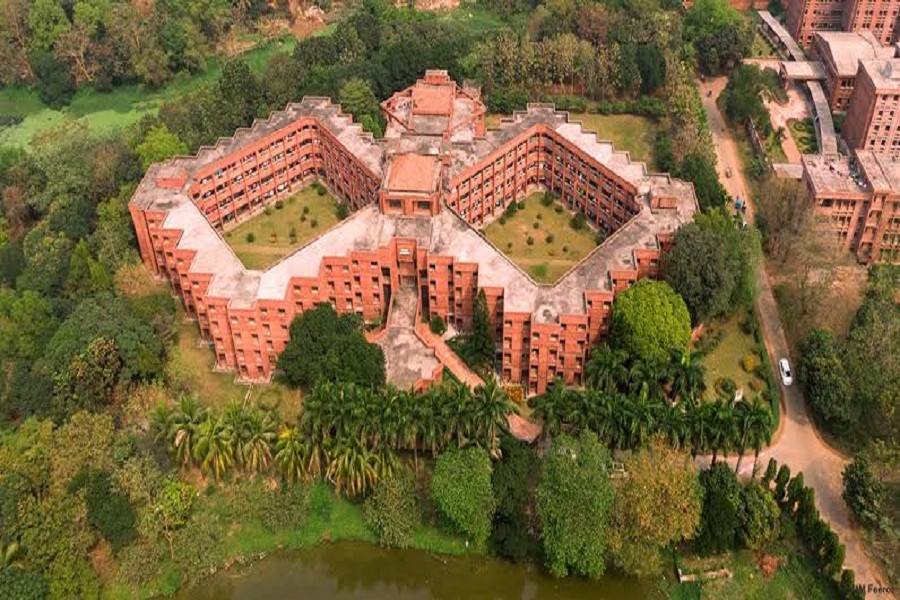
Published :
Updated :

Jahangirnagar University, the queen of natural beauty, the country's cultural capital, is famous for its unique green landscape, exuberant cultural activities and tourist destination of migratory birds of arctic countries has crossed 52 years of its establishment on today (January 12).
The university, a calm and tranquil campus full of the intense fragrance of Chhatim (Alstonia Scholais) and ablaze Red Krishnachura (Delonix), Lotus-Lillies and diverse wildlife, was inaugurated on January 12, 1971. Today is the 52nd birth anniversary of Jahangirnagar University.
The context of the establishment
In 1964, the then Government of Pakistan wanted to establish a university adjacent to the Capital with a full residential facility. As a result, in 1965, the executive body of the National Economic Council approved the plan.
Primarily it was decided to establish at Salna in Gazipur, 40 km from Dhaka. But in 1967, a place was decided for this university on the western side of the Dhaka-Aricha highway at Savar, 32 kilometres away from the capital.
At the time of its establishment, 750 acres of land were allocated for this university, but in the 80s, 50 acres of land was given to Bangladesh Public Administration Training Center.
Jahangirnagar Muslim University to Jahangirnagar University
Actually, 'Jahangirnagar Muslim University' was established in 1970, commemorating the ancient name of the Mughal Period, Jahangirnagar. But in the University Ordinance of 1973, the word Muslim was amended, and it was named Jahangirnagar University (JU).
Although the first class started on January 4, 1971, the university was formally inaugurated by the then Governor of East Pakistan, Rear Admiral S M Ahsan, on January 12. Professor Mofiz Uddin was appointed as the first Vice-Chancellor of the University on 24 September 1970.
JU now, JU then
The university initially started with only 4 departments, 21 teachers and 150 students. Now, it accommodates 34 departments under 6 faculties, and 4 institutes under the supervision of around 700 teachers, and about 15000 students are studying here.
This university has 16 residential halls, 8 each for boys and girls. Six more halls are to be inaugurated soon after the last phase of construction.
Jahangirnagar University is not only the land of beauty but also known as the cultural capital of the country.
'Selim Al Din Muktamancha' remains busy with various cultural activities throughout the year, including play, debate, recitation, dance, and musical events. In the afternoon, friends gather, have tea, sing and chat at the Amphitheatre, Central Playground, Cafeteria premises, Tarzan Point, Shaheed Minar and other places.
Those who make JU indebted
In its long journey, this university produced many veteran people in different fields. Among them are famous poet Syed Ali Ahsan, Professor Mustafa Nurul Islam, writer Humayun Azad, playwright Salim Al-Din, poet Mohammad Rafiq, Economist and political personality Anu Muhammad, international political analyst Prof. Tarek Shamsur Rehman, chemist Prof. Sharrif Enamul Kabir, historian AKM Shahnawaz and others.
In the cultural and sports arena, Mushfiqur Rahim, Mashrafe bin Mortaza, Humayun Faridi, Shahiduzzaman Salim, Farooq Ahmed, Subhashish Bhowmik, Zakia Bari Mom, Vidya Sinha Meem, Sumaiya Shimu and others studied here.
Few sculptures of JU
The longest Shaheed Minar in the country has been built in this university by cherishing the history and heritage of the Bengali nation.
'Amar Ekushe' sculpture has been built in memory of language martyrs. The memorial sculpture 'Sangshaptak' has been built in honour of the brave children of the country who lost their hands and feet in the war of independence.
Protests on JU
The students of this university have played a significant role in national and internal movements. They voluntarily participated in the liberation war of 1971. 'Shikkha Andolon' during the Ershad Regime and the Anti-Dictatorship Mass Movement of 1990, students protested.
Notorious Chhatra League leader Manik and his companions, who were accused of rape in 1998, could not survive in the face of the students' agitation on this campus. This movement is also known as the largest anti-sexual harassment movement in South Asia.
What do the students opine?
Noman Bin Harun, a fourth-year student of the Law and Justice Department, spoke about the natural beauty of Jahangirnagar, "Maybe Jahangirnagar is the only place where six seasons and their changes are noticed. In the last four years of my study, with the change of seasons, it has been seen very closely how the calm greenland becomes rough and dry and then is decorated with colourful flowers and fruits."
"It is beyond description that this campus has introduced us to the charming fragrance of Chhatim (Alstonia scholaris), a flower, the lotus- lilies of the transparent lakes, the faint fragrance of the Kathgolap (Frangipani/ Plumeria)."
Wazhatul Islam, a student of the Department of Public Administration, made some criticism, saying, "Many trees have been felled due to ongoing development projects. The wildlife has been so adversely affected that where six or seven lakes were visited by migratory birds every year, only two lakes are being visited by a few birds this year. Though it is called fully residential, it lost its residential nature many years ago. First, second and even third-year students have to reside in inhumane conditions."
"We demand Jahangirnagar University Central Students' Union (JUCSU) be in operation. Wazed Mia Science Research Center is said to be the largest research centre in the country, but we did not know about any visible breakthrough research."
Despite these crises, for its grace and glory, it is hoped that Jahangirnagar University will become the highest institution in the country in terms of producing knowledge and nurturing scholars.
sojib.mhs@gmail.com


 For all latest news, follow The Financial Express Google News channel.
For all latest news, follow The Financial Express Google News channel.